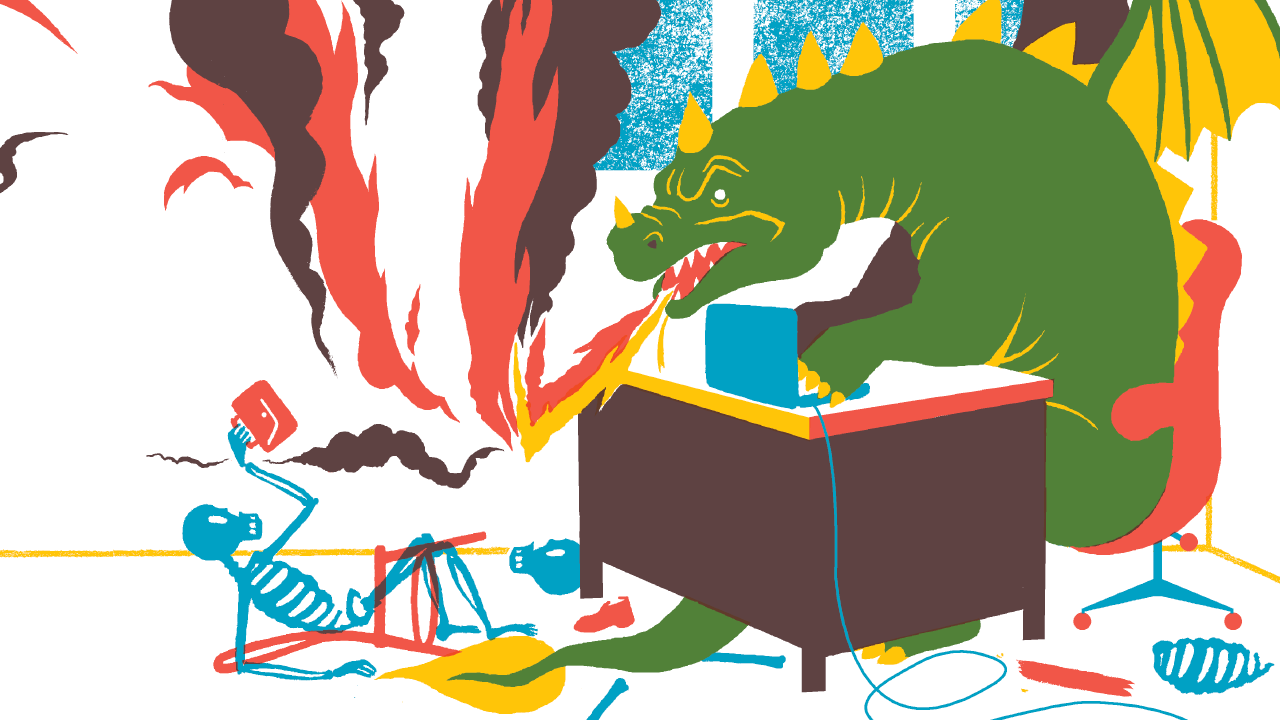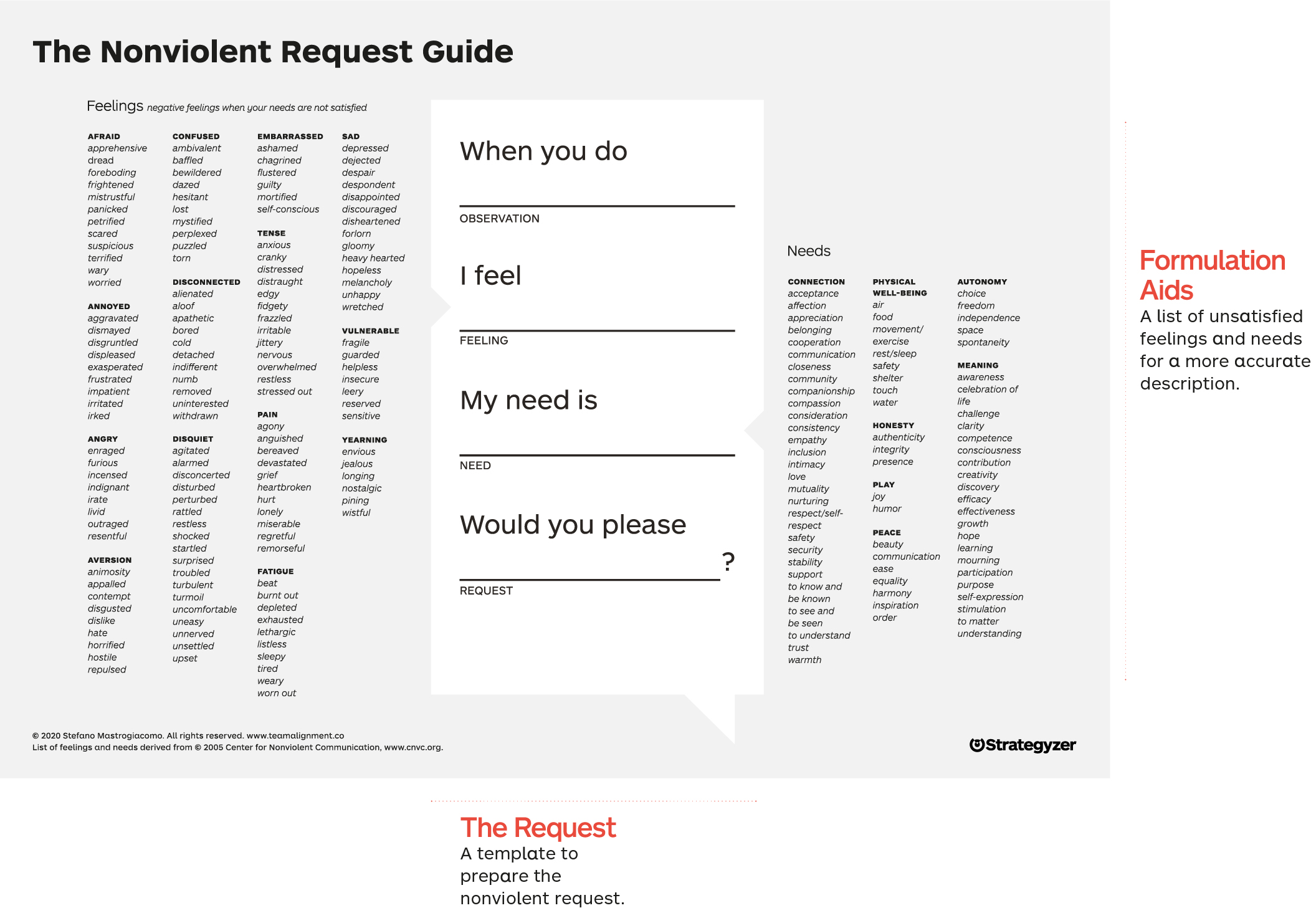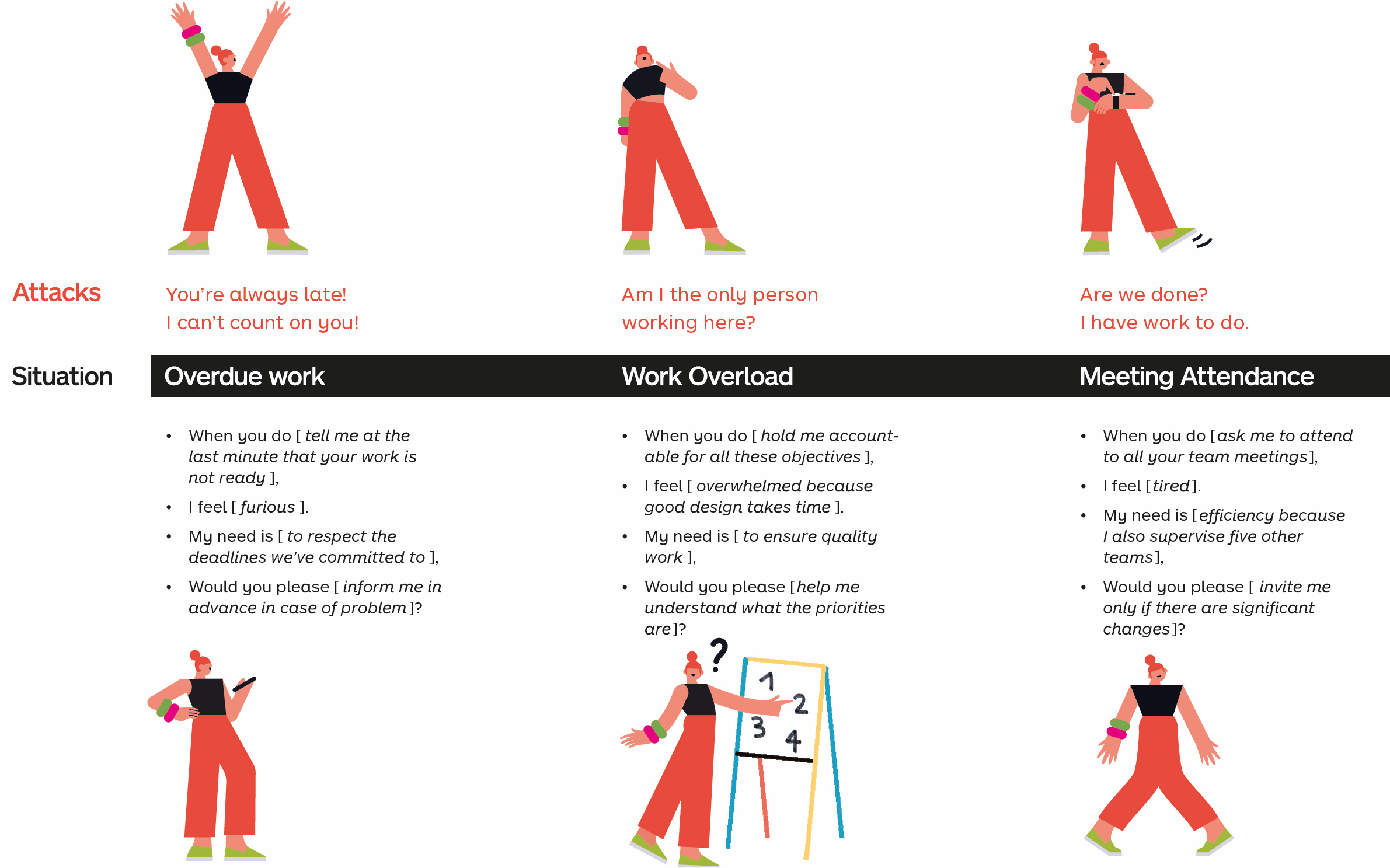Navigating Conflict Constructively with the Nonviolent Requests Guide
Nov 09, 2021
by Stefano Mastrogiacomo
Anger is the expression of unmet needs.
Marshall Rosenberg
"Enough of the nonsense. You created this problem, now solve it!" an irate technical manager once bellowed at his team struggling to fix a bug. We were present.
This kind of communication is counterproductive if the aim is to rectify the problematic code. Emma Seppala, a lecturer at Yale School of Management, suggests in her article, "Why Compassion Is a Better Managerial Tactic than Toughness," that publicly accusing or demeaning others is one of the worst strategies to get things back on track. While it might temporarily alleviate our stress and anger, it eventually undermines trust in our leadership, diminishing team commitment, productivity, and innovation.
So, what's the better approach? Empathy. Seppala notes that a more empathetic response yields more potent results, a stance supported by numerous studies and experts. True innovation arises in an environment where team members can converse openly and honestly without fear of judgment or repercussions.
This concept is known as "psychological safety," a term coined by Amy Edmondson, a Harvard Business School Professor of Leadership and Management. Her theories were implemented by Google following a comprehensive two-year study on team performance, Project Aristotle.
Drawing from our experiences, we developed a tool to assist leaders and teams in accelerating empathy practice and implementing techniques to create psychologically safer environments. The Nonviolent Requests Guide is designed for easy application in high-stress situations, facilitating more constructive conflict resolution.
The Nonviolent Communication framework enhances mediation and communication skills and is rooted in the work of American psychologist Marshall Rosenberg, who examined the origins of public school violence in the 1960s.
Rosenberg found that when we lack the emotional skills to articulate our dissatisfaction, we tend to issue unproductive judgments and criticisms perceived as attacks by others. Instead of saying, "You lied to me" or "You're not accountable," we should express, "I am disappointed because you promised to deliver this work today."
In his book, Nonviolent Communication, Rosenberg asserts, "When we express our needs indirectly using evaluations, interpretations, and images, others are likely to hear criticism. And when people hear anything that sounds like criticism, they tend to invest their energy in self-defense or counterattack."
Expressing Discontent Constructively: Here’s How It Works
To adapt the language of nonviolent statements, incorporate its four aspects:
- Observations: the concrete actions we observe that affect our well-being.
- Feelings: how we feel in relation to what we observe.
- Needs: the needs, values, desires, etc., that generate our feelings.
- Requests: the concrete actions we request to enrich our lives.
By structuring nonjudgmental requests, we can express disagreements without making others feel personally attacked, thereby creating an opportunity for empathic dialogue and conflict resolution.
So, how should you respond the next time you feel upset, panicked, or simply unhappy with your colleagues?
1. Hit the pause button. Step back before saying anything and apologize for leaving the room if necessary. Recognize and accurately name your current feelings and needs (using the right and left checklists of the Nonviolent Requests Guide). These lists, developed by the Center for Nonviolent Communication, are invaluable in developing the emotional vocabulary and skills that many of us lack. Repeat to yourself, "I feel [feeling], while my need is [need]."
2. Build your nonviolent request. Construct your nonviolent request. Using the central template, build your nonviolent request. For example, "When you reject my idea just 2 minutes into the presentation, I feel frustrated because we worked six months to get this project off the ground. My need is to contribute to the success of our business. Could you help me understand your decision?" Once confident with your request, prepare by asserting to yourself, "My goal now is to get an answer to my request."
3. Deliver your request. Deliver your request. Present your request to your colleague or team with the objective of getting an answer. Listen and then build on the others' responses. If you sense that negative emotions are still running strong, ask, "Can you help me understand what makes/for what reason/how …" and observe the power of empathetic, non-violent communication in action. After the interaction, ask yourself, "What did I learn from this experience?"

Examples: 
Nonviolent Communication Contributed to Microsoft's Product Renewal
Empathy pays.
The media portrayed Microsoft as a company plagued by internal fights and inertia when Satya Nadella took over as CEO, in 2014. Both Wall Street and Silicon Valley considered the company on the decline. Microsoft needed a cultural transformation on an organizational level if it was to get the innovation machine rolling again.
Rapidly, Nadella required his top executives to read Marshall Rosenberg’s book Nonviolent Communication – in an effort to instill empathetic collaboration. What this signaled was Nadella’s intention to lead the company differently than his predecessors, thus changing Microsoft's reputation as a hive of intense internal competition and conflict. The reading assignment “was the first clear indication that Satya was going to focus on transforming not just the business strategy, but the culture as well,” said Microsoft president and chief legal officer Brad Smith.
Nadella's initiative helped instill more empathetic behaviors and better conflict management, which he termed "learn-it-all" curiosity behaviors. Adopting genuine team learning behaviors, such as discussing mistakes, requesting help, or sharing information, is crucial for innovation teams aiming to solve intricate problems in today's rapidly evolving marketplace. Nadella modeled the change, and starting with his top lieutenants, the new, more empathetic culture took root. “He has a hugely proactive and incredibly connected listening [style]. So he’s with you, you can feel it. You can see the body language. And it doesn’t matter if you’re a top executive or a first-line seller, he has exactly the same quality of listening,”
Today, Nadella boasts a 98% employee approval rate on Glassdoor, and Microsoft's share price soared from USD 40 in 2015 to USD 250 in 2021, resulting in a market cap of 1.93T.
Take Action
Get your copy of High-Impact Tools for Teams, Wiley, Strategyzer Series, 2021.
Download the Nonviolent Requests Guide for free.
Credits
Cover illustration by BlexBolex, other illustrations by Severine Assous, www.illustrissimo.fr
References
Duhigg, C. (2016). What Google learned from its quest to build the perfect team. The New York Times Magazine, 26(2016), 2016. https://www.nytimes.com/2016/02/28/magazine/what-google-learned-from-its-quest-to-build-the-perfect-team.html
Edmondson, A. (1999). Psychological safety and learning behavior in work teams. Administrative science quarterly, 44(2), 350-383.
Ibarra, H., & Rattan, A. (2018). Microsoft: instilling a growth mindset. London Business School Review, 29(3), 50-53.
Ibarra, H., & Scoular, A. (2019). The leader as coach. Harvard Business Review, 97(6), 110-119. https://hbr.org/2019/11/the-leader-as-coach
Kim, W., & Mauborgne, R. (1997). Fair process. Harvard business review, 75, 65-75.
Mastrogiacomo, S., & Osterwalder, A. (2021). High-Impact Tools for Teams: 5 Tools to Align Team Members, Build Trust, and Get Results Fast (Vol. 5). John Wiley & Sons.
McCracken, H. (2017). Satya Nadella Rewrites Microsoft’s Code. Fast Company. https://www.fastcompany.com/40457458/satya-nadella-rewrites-microsofts-code
Rosenberg, M. B., & Chopra, D. (2015, 3rd Edition). Nonviolent communication: A language of life: Life-changing tools for healthy relationships. PuddleDancer Press.
Seppala, E. (2015). Why compassion is a better managerial tactic than toughness. Harvard Business Review, 7. https://hbr.org/2015/05/why-compassion-is-a-better-managerial-tactic-than-toughness
Wacker, R., & Dziobek, I. (2018). Preventing empathic distress and social stressors at work through nonviolent communication training: A field study with health professionals. Journal of occupational health psychology, 23(1), 141.

